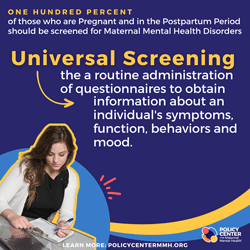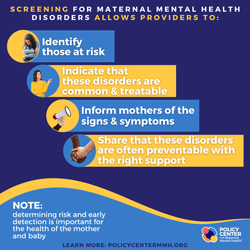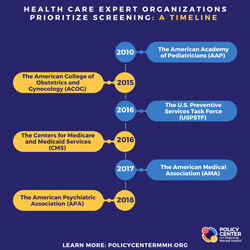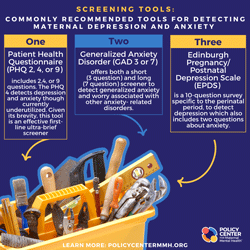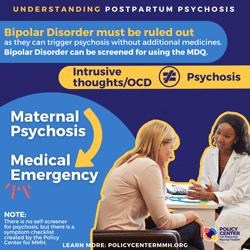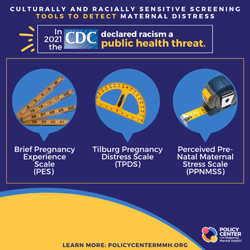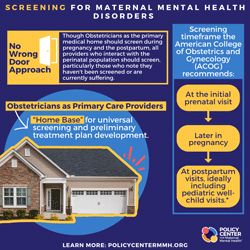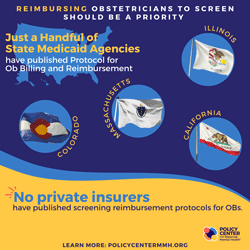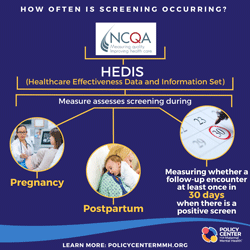SCREENING OVERVIEW
What is Screening and Who Does It?
Screening for postpartum depression and other maternal mental health disorders, is the first step in educating women about the risk, signs and symptoms and detecting potential disorders. Because there isn’t yet a medical diagnostic test, like a blood or saliva test to detect potential mental health disorders, questionnaires (referred to as screening tools) are used.
Screening for maternal mental health disorders can be administered in various settings and by various health care professionals, trained support staff, or be completed by the individual. Screening tools are available in various forms and languages, including paper, web-based (medical and non-medical sites), questions read by a health care professional through an electronic medical record interface, and smartphone apps.
After the screening tool is administered, a score is derived to identify whether the patient screened positive or negative for a mental health disorder. A positive screening score does not necessarily confirm a diagnosis; a more thorough diagnostic evaluation by a healthcare professional with adequate training in maternal mental health may be necessary. Such providers could include being Perinatal Mental Health-Certified, or completing training through the National Curriculum in Reproductive Psychiatry for example.
Screening is an assessment, it is an opportunity for conversation and can open the door for those struggling to recognize they are in a safe place to have mental health conversations.
Read below to learn more about the screening tools researchers consider valid in detecting these disorders.
When Should Screening Occur?
At a minimum, based on recommendations from various professional provider associations and in conjunction with the Healthcare Effectiveness Data and Information Set (HEDIS), 2020 Mom recommends screening happen during the following intervals:
During Pregnancy: At least once, ideally late in the first trimester or early in the second trimester.
Those who are pregnant should be informed about and screened for maternal mental health disorders by their obstetricians or support staff when pregnancy is confirmed. This is because new onset of these disorders occurs almost as frequently during pregnancy as in the postpartum period, and many who are childbearing age have pre-existing and undiagnosed/untreated anxiety and depression. Screening should occur at least once more during pregnancy, ideally late in the first trimester or early in the second trimester.
In the Postpartum Period: At least once, at the six week obstetric postpartum visit and ideally at least one additional time through the first year after birth.
30 Days After an Initial Positive Screen
Obstetricians are now being monitored by payors using the HEDIS maternal depression screening measure, for screening at least once during the perinatal period and for those who screen positive, for administering another screening 30 days after the positive screen.
Of note, there are several provider screening applications that have generally been developed by private mental health start-ups that are now available to help streamline the screening process for health care providers. This includes using branching logic to present the next appropriate tool if a second or third screening is warranted. These tools may also provide the screening provider with the billing codes to submit for reimbursement.
What about Reimbursement for Screening to Ob/Gyns and Midwives?
These Obstetric providers are generally reimbursed through Medicaid and private insurance through a 'global' maternity care capitation rate. We believe that these providers should be reimbursed for screening (and treatment) either by increasing the global capitaiton rate or reimbursing on a fee-for-service basis.
Learn which 10 states have taken steps to improve reimbursement for Ob providers as of March 2023 here.
Read more about screening in our Universal Screening for Maternal Mental Health Disorders Issue Brief. Download Now.
Click on an infographic to view larger and download the image to share on social media.
Recommended Citation:
2020 Mom. (2022, March). Universal Screening for Maternal Mental Health Disorders [Issue Brief]. https://www.2020mom.org/issue-briefs-and-papers
The following information is intended for healthcare professionals. If you are a mother (or supporter) seeking screening, we encourage you to provide this page to your healthcare professional.
What Disorders Should be Screened For?
Overview
There are a number of research-validated tools to detect maternal mental health disorders, including but not limited to depression.
As obstetric and other providers are just beginning to routinely screen, commonly they use tools to detect depression, and may not use other important recommended tools.
When may multiple screening tools be necessary?
Here are examples of why and when multiple tools are warranted:
Anxiety is more common than depression and can be a precursor to depression; screening for both anxiety and depression is recommended.
Also, because “intrusive thoughts” are unwanted and often disturbing and repetitive can be extremely distressing for a patient, experts are recommending an OCD screener be administered to any patient who screens positive for anxiety or raises concerns about recurring unwanted thoughts. As prescribing an antidepressant to a person with an unknown bipolar disorder can trigger a manic episode which could lead to psychosis, every patient who screens positive for depression should be screened for bipolar disorder before an antidepressant is prescribed. If a patient is suspected of having postpartum psychosis screening for OCD should occur before a treatment plan is developed or a woman is sent to the Emergency Room (ER) because psychosis can be confused with maternal OCD/intrusive thoughts.
Risk of suicide should be screened for if a person verbally discloses she has had thoughts of suicide or ending her life or answers yes to question 9 on the PHQ-9 or question 10 on the EPDS.
In populations whose cultures are less likely to acknowledge mental health challenges, screening for sleep disturbances, a symptom of nearly all mental health disorders, can be another way to identify a potential mental health issue.
At a Minimum
All patients should be screened for generalized anxiety and depression, and the logic described in the “When are Multiple Tools Necessary” section above should be applied. Additionally, if a patient identifies with or self-describes other symptoms, the screening provider should use judgment in determining which additional tools below should be used.
What Screening Tools Should Be Used?
Below is a list of the tools that are research validated and easily accessible by health care professionals.
Research validity in surveys relates to the extent at which the survey measures what it intends to measure. In this case, a survey is “validated” as detecting likely maternal mental health disorders
Are there Additional Non-Diagnostic-Related Screeners that Should be Used?
We also list below questionnaires that are helpful in detecting risk for MMH disorders and one that assesses for support.


